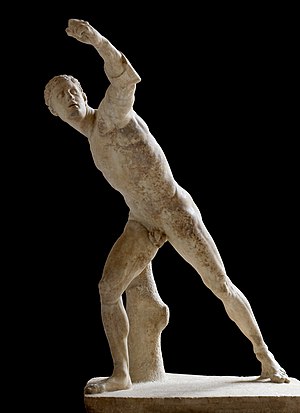Borghese Gladiator
| Borghese Gladiator | |
|---|---|
 |
|
| Artist | Agasias of Ephesus (signature) |
| Year | c.100 BCE |
| Type | Marble |
| Dimensions | 199 cm (78 in) |
| Location | Musée du Louvre, Paris |
The Borghese Gladiator is a Hellenistic life-size marble sculpture portraying a swordsman, created at Ephesus about 100 BCE.
The sculpture is signed on the pedestal by Agasias, son of Dositheus, who is otherwise unknown. It is not quite clear whether the Agasias who is mentioned as the father of Heraclides is the same person. Agasias, son of Menophilus may have been a cousin.
It was found before 1611, in the present territory of Anzio south of Rome, among the ruins of a seaside palace of Nero on the site of the ancient Antium (modern Anzio and Nettuno). From the attitude of the figure it is clear that the statue represents not a gladiator, but a warrior contending with a mounted combatant. In the days when antique sculptures gained immediacy by being identified with specific figures from history or literature,Friedrich Thiersch conjectured that it was intended to represent Achilles fighting with the mounted Amazon, Penthesilea.
The sculpture was added to the Borghese collection in Rome. At the Villa Borghese it stood in a ground-floor room named for it, redecorated in the early 1780s by Antonio Asprucci. Camillo Borghese was pressured to sell it to his brother-in-law, Napoleon Bonaparte, in 1807; it was taken to Paris when the Borghese collection was acquired for the Louvre, where it now resides.
Misnamed a gladiator due to an erroneous restoration, it was among the most admired and copied works of antiquity in the eighteenth century, providing sculptors a canon of proportions. A bronze cast was made for Charles I of England (now at Windsor), and another by Hubert Le Sueur was the centrepiece of Isaac de Caus' parterre at Wilton House; that version was given by the 8th Earl of Pembroke to Sir Robert Walpole and remains the focal figure in William Kent's Hall at Houghton Hall, Norfolk. Other copies can be found at Petworth House and in the Green Court at Knole. Originally a copy was also located in Lord Burlington's garden at Chiswick House and later relocated to the gardens at Chatsworth in Derbyshire. In the United States, a copy of "The Gladiator at Montalto" was among the furnishings of an ideal gallery of instructive art imagined by Thomas Jefferson for Monticello.
...
Wikipedia
